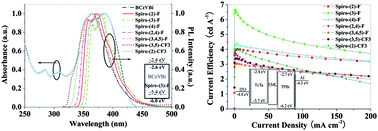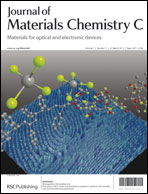A series of new fluorinated 9,9′-spirobifluorene derivatives (SFs) have been designed and synthesized for organic light-emitting devices (OLEDs). The spatial structure of 2,2′,7,7′-tetrakis(2,4-bifluorophenyl)spiro-9,9′-bifluorene was determined by X-ray diffraction analysis. With the different substitution patterns of electron-withdrawing groups, such as F and CF3, the photophysical properties, energy levels and thermal stabilities of these SFs can be tuned, which is supported by density functional studies of their geometries and electronic structures. A non-doped deep blue OLED using 2,2′,7,7′-tetrakis(3-fluorophenyl)spiro-9,9′-bifluorene (Spiro-(3)-F) as the emitter shows excellent Commission Internationale de l'Éclairage (CIE) coordinates of (0.169, 0.122) with emission peaking at ca. 408 nm. Furthermore, these SFs serve as an excellent host material for the 4,4′-bis(9-ethyl-3-carbazovinylene)-1,1′-biphenyl dopant to form high-performance OLEDs with low turn-on voltages and high efficiencies, especially for Spiro-(3)-F as the fluorescent host with pure blue CIE coordinates of (0.149, 0.187), a low turn-on voltage of 3.4 V, high luminance of over 10 000 cd m−2, a high current efficiency of 6.66 cd A−1, and a high external quantum efficiency of 4.92%. The high efficiency is attributed to the high carrier mobility together with the low injection barriers for both the electron and the hole in the Spiro-(3)-F-based device.


 Please wait while we load your content...
Please wait while we load your content...